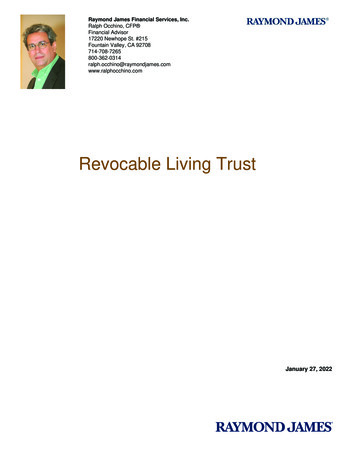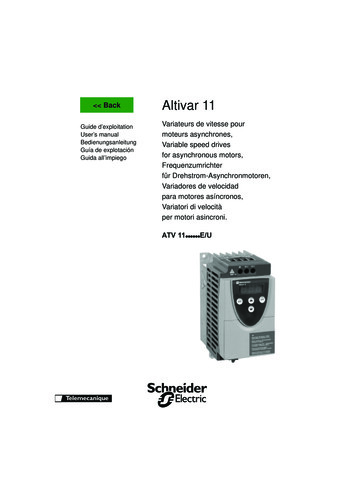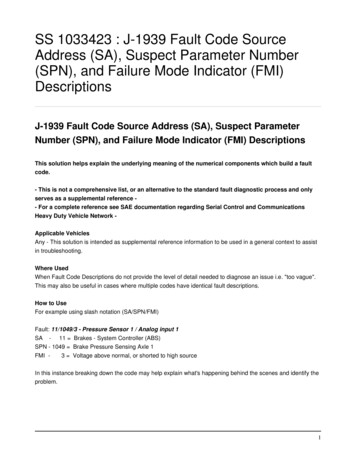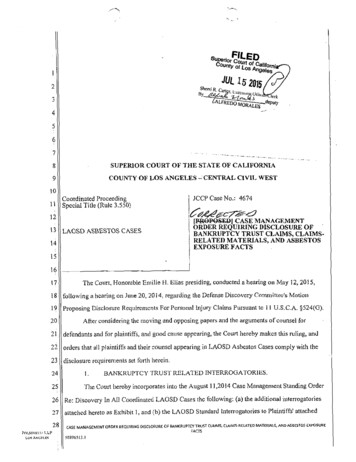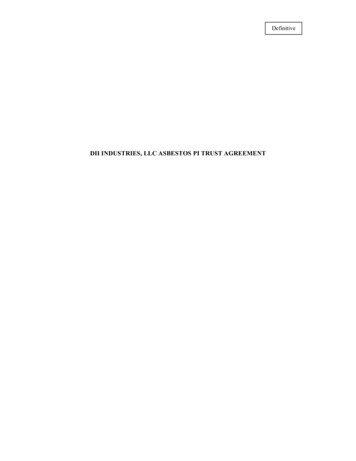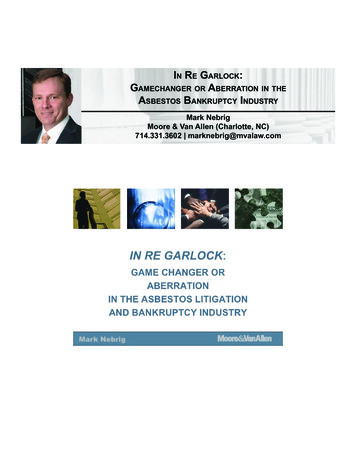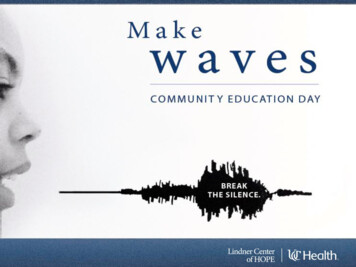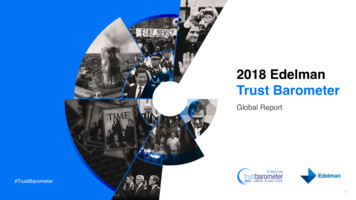
Transcription
Concentrated Knowledge for the Busy Executive www.summary.comVol. 28, No. 11 (3 parts), Part 1, November 2006 Order # 28-26The One Thing That Changes EverythingTHE SPEEDOF TRUSTTHE SUMMARY IN BRIEFBy Stephen M. R. Covey withRebecca MerrillCONTENTSNothing Is as Fast as theSpeed of TrustPages 2, 3Myth vs. RealityPage 2You Can Do SomethingAbout This!Page 3The First Wave: Self-TrustPages 3, 4The Second Wave:Relationship TrustPages 5, 6Stakeholder Trust: TheThird, Fourth and FifthWavesPages 6, 7eBay Creates TransparencyPage 6Inspiring TrustPages 7, 8There is one thing that is common to every individual, relationship,team, family, organization, nation, economy and civilization throughout theworld — one thing which, if removed, will destroy the most powerful government, the most successful business, the most thriving economy, the mostinfluential leadership, the greatest friendship, the strongest character, thedeepest love.On the other hand, if developed and leveraged, that one thing has thepotential to create unparalleled success and prosperity in every dimensionof life.That one thing is trust.The Five Waves of Trust model serves as a metaphor for how trustoperates in our lives. This summary will cover these forms as the structurefor understanding and making trust actionable, including a look at theFour Cores of credibility and the 13 Behaviors of high-trust leaders.The summary concludes with a section on restoring lost trust on thesocietal, market, organizational, relationship and personal level.In all cases, the Four Cores and 13 Behaviors provide powerfulrestoration models.What you will learn in this summary: The economics of trust and its effects on speed and cost in relationships and organizations. How you can assess your credibility based on character andcompetence. The 13 Behaviors common in people with high-trust relationships. The taxes and dividends that flow from organizational trust. How micro trust issues in the self and in relationships flow outwardto affect market reputation and societal contribution. How to be an effective leader by inspiring and extending trust. How to restore lost trust.Smart Trust MatrixPage 7Published by Soundview Executive Book Summaries, P.O. Box 1053, Concordville, PA 19331 USA 2006 Soundview Executive Book Summaries All rights reserved. Reproduction in whole or part is prohibited.FILE: PERSONAL
THE SPEED OF TRUSTBy Stephen M.R. Covey with Rebecca Merrill— THE COMPLETE SUMMARYNothing Is as Fast as theSpeed of TrustSimply put, trust means confidence. The opposite oftrust — distrust — is suspicion.The difference between a high- and low-trust relationship is palpable. Take communication. In a high-trustrelationship, you can say the wrong thing and peoplewill still get your meaning. In a low-trust relationship,you can be very measured, even precise, and they’ll stillmisinterpret you.You don’t need to look far to realize that, as a globalsociety, we have a crisis of trust on our hands. On theorganizational level, trust within companies has sharplydeclined. But relationships of all kinds are built on andMyth vs. RealityMythRealityTrust is soft.Trust is hard, real andquantifiable. Itmeasurably affectsboth speed and cost.Nothing is as fast asthe speed of trust.Trust is a function ofboth character andcompetence.Trust can be bothcreated and destroyed.Though difficult, inmost cases lost trustcan be restored.Trust can be effectivelytaught and learned, andit can become aleverageable, strategicadvantage.Not trusting people isa greater risk.Establishing trustwith the one establishestrust with the many.Trust is slow.Trust is built solelyon integrity.You either have trustor you don’t.Once lost, trustcannot be restored.You can’t teach trust.Trusting peopleis too risky.You establish trustone person at a time.sustained by trust. They can also be broken down anddestroyed by a lack of trust.Society, organizations and relationships aside, there’san even more fundamental and powerful dimension toself-trust. If we can’t trust ourselves, we’ll have a hardtime trusting others. Personal incongruence is often thesource of our suspicions of others.Truly, we are in a crisis of trust. It affects us on alllevels — societal, institutional, organizational, relationaland personal.Economics of TrustTrust always affects two outcomes: speed and cost.When trust goes down, speed goes down and cost goesup. Consider the time and cost of airport security after9/11, or costs for Sarbanes-Oxley Act compliance,passed in the U.S. in response to Enron, WorldCom andother corporate scandals.When trust goes up, speed goes up and cost goesdown. Warren Buffett completed the acquisition ofMcLane Distribution from Wal-Mart on the basis of atwo-hour meeting. Because of high trust between theparties, the merger took less than a month and avoidedthe usual months and millions for due diligence andattorneys.(continued on page 3)The authors: Stephen M. R. Covey is co-founder andCEO of CoveyLink Worldwide. A sought-after and compelling keynote speaker, author and advisor, Coveyaddresses audiences around the world on issues such astrust, leadership, ethics and high-performance.Rebecca R. Merrill is an accomplished writer. She isco-author with Stephen R. Covey and Roger Merrill ofThe New York Times bestseller First Things First and coauthor with Roger Merrill of Life Matters andConnections.The Speed of Trust by Stephen M.R. Covey withRebecca R. Merrill. Copyright 2006 by Simon &Schuster, Inc. Summarized by permission of the publisher, 384 pages, 26.00. ISBN 0-7432-9730-1.Summary Copyright 2006 by Soundview ExecutiveBook Summaries. www.summary.com, 1-800-SUMMARY, 1-610-558-9495.For additional information on the author,go to: http://my.summary.comPublished by Soundview Executive Book Summaries (ISSN 0747-2196), P.O. Box 1053, Concordville, PA19331 USA, a division of Concentrated Knowledge Corp. Published monthly. Subscriptions: 209 per year in theUnited States, Canada and Mexico, and 295 to all other countries. Periodicals postage paid at Concordville, Pa.,and additional offices.Postmaster: Send address changes to Soundview, P.O. Box 1053, Concordville, PA 19331. Copyright 2006by Soundview Executive Book Summaries.Available formats: Summaries are available in print, audio and electronic formats. To subscribe, call us at1-800-SUMMARY (610-558-9495 outside the United States and Canada), or order on the Internet at www.summary.com.Multiple-subscription discounts and corporate site licenses are also available.2Soundview Executive Book Summaries SoundviewExecutive Book Summaries GREER MCPHADEN – Contributing EditorDEBRA A. DEPRINZIO – Senior Graphic DesignerLINDA GROSS – Editor in ChiefREBECCA S. CLEMENT – Publisher
The Speed of Trust — SUMMARYNothing Is as Fast as the Speed of Trust(continued from page 2)The serious practical impact of the economics of trustis that we are paying a hidden low-trust tax right off thetop — and we don’t even know it!You’ve undoubtedly seen this tax in action manytimes — perhaps in a conversation where you can tellthat someone is automatically discounting everythingyou say by 20 percent, 30 percent or even more. Insome situations, you may have paid an “inheritance tax”when you’ve stepped into a role that was occupied bysomeone who created distrust before you.Just as the tax created by low trust is real, measurableand extremely high, so the dividends of high trust arealso real, quantifiable and incredibly high.Whether it’s high or low, trust is the “hidden variable”in the formula for organizational success. The traditional business formula is:(Strategy x Execution Results).But there is a hidden variable:(Strategy x Execution) x Trust Results.A company can have an excellent strategy and astrong ability to execute; but the net result can be torpedoed by a low-trust tax or multiplied by a high-trust dividend. This makes a powerful business case for trust,assuring that it is not a soft, “nice to have” quality.One of the reasons this hidden variable is so significant in today’s world is that we have entered a global,knowledge worker economy that revolves around partnering and relationships. The ability to establish, grow,extend and restore trust with all stakeholders — customers, suppliers and co-workers — is the key leadership competency of the new, global economy. You Can Do SomethingAbout This!Who do you trust? A friend? A work associate? Yourboss? Why do you trust this person? What is it thatinspires confidence in this particular relationship?Now consider an even more provocative question:Who trusts you?With the increasing focus on ethics in our society, thecharacter side of trust is fast becoming the price of entryin the new, global economy. However, the differentiating and often ignored side of trust — competence — isequally essential.Once you become aware that both character and competence are vital to trust, you can see how the combination of these two dimensions is reflected in the approachof effective leaders and observers everywhere. Peoplemight use different words to express the idea, but if youreduce the words to their essence, what emerges is abalancing of character and competence.The Five Waves of TrustYour boss, division leader, CEO, board of directors,spouse, children, friends and associates may all haveproblems as far as trust (or anything else) is concerned.But that does not mean that you are powerless! Infact, you probably have no idea how powerful you canbe in changing the level of trust in any relationship ifyou know how to work “from the inside out.”The key is in understanding and learning how to navigate “The Five Waves of Trust.” This model derivesfrom the “ripple effect” metaphor that graphically illustrates the interdependent nature of trust and how it flowsfrom the inside out.It defines the five levels, or contexts, in which weestablish trust. It also forms the structure for understanding and making trust actionable.First Wave: Self Trust. The key principle underlyingthis wave is credibility.Second Wave: Relationship Trust. The key principleunderlying this wave is consistent behavior.Third Wave: Organizational Trust. The key principle underlying this wave, alignment, helps leaders createstructures, systems and symbols of organizational trust.Fourth Wave: Market Trust. The underlying principle behind this wave is reputation.Fifth Wave: Societal Trust. The principle underlyingthis wave is contribution.Understanding these waves will enable you to see,speak and behave in ways that establish trust, allowingyou to become a leader who gets results by inspiringtrust in others. The First Wave: Self-TrustThe good news is that we can increase our credibility,and we can increase it fast, particularly if we understandthe four key elements, or four “cores” that are fundamental. Two of these cores deal with character; twowith competence.Core 1: IntegrityTo use the metaphor of the tree, integrity is the root.Even though it’s underground and not even visible mostof the time, it is absolutely vital to the nourishment,strength, stability and growth of the entire tree.We’ve all seen people with enormous capability,strong results, even sometimes good intent who unfortunately go about what they’re doing in a dishonest orunprincipled way. It’s “the ends justify the means” mentality.Soundview Executive Book Summaries (continued on page 4)3
The Speed of Trust — SUMMARYThe First Wave: Self-Trust(continued from page 3)On the other hand, to have integrity only — and not theother three Cores — is to be a “nice guy,” maybe even athoroughly honest person, who is basically useless.To most people, integrity means honesty — telling thetruth and leaving the right impression. But there are atleast three additional qualities: congruence, humilityand courage.So how do we go about increasing our integrity?1. Make and keep commitments to yourself.2. Stand for something.3. Be open.Core 2: IntentIn the dictionary, intent is defined as “plan” or “purpose.” No discussion of intent would be complete without talking about three things: motive, agenda andbehavior.1. Motive. Motive is your reason for doing something,and it inspires the greatest trust when it shows genuineconcern for people, purposes and society as a whole.2. Agenda. Agenda grows out of motive. It’s what youintend to do or promote because of your motive. Theintent that inspires the greatest trust is seeking mutualbenefit, realizing that life is interdependent and seekingsolutions that build trust and benefit for all.3. Behavior. Typically, behavior is the manifestationof motive and agenda. The behavior that best createscredibility and inspires trust is acting in the best interestof others. This is where the rubber meets the road. It’seasy to say “I care,” and “I want you to win,” but it isour actual behavior that demonstrates whether or not wemean it.In many organizations, the message communicated bybehavior is not “we care;” it’s “you’re expendable.”Consider these findings from a study: Only 29 percent of employees believe that management cares about them developing their skills. Only 42 percent believe that management caresabout them at all.It’s important to keep in mind that sometimes, unfortunately, poor behavior turns out to be bad execution ofgood intent.1. Examine and redefine your motives. It’s humantendency to assume we have good — or at least justifiable — intent.2. Declare your intent. It signals your behavior andlets people know what to look for so they acknowledge it when they see it.3. Choose abundance. Abundance means there is4enough for everybody. The opposite — scarcity —says that there is only so much to go around, and ifyou get it, I won’t.Role models, insightful thought leaders and practitioners serve as powerful reminders that we can dosomething about even the very deep, personal, character-based issues that impact our credibility, which is theprerequisite for trust.Core 3: CapabilitiesGoing back to the metaphor of the tree, capabilitiesare the branches that produce the fruits or results.Capabilities are particularly essential in today’s changing economy, where technology and globalization areoutdating skill sets faster than ever before.One way to think about the various dimensions ofcapabilities is to use the acronym TASKS (Talents,Attitudes, Skills, Knowledge, Style).Talents are our natural gifts and strengths. Attitudesrepresent our paradigms — our way of seeing — aswell as our ways of being. Skills are our proficiencies,the things we can do well. Knowledge represents ourlearning, insight, understanding and awareness. Stylerepresents our unique approach and personality.The end in mind here is to develop our TASKS and tocreate the best possible alignment between our naturalgifts, our passions, our skills, knowledge and style andthe opportunity to earn, to contribute, to make a difference.To enhance credibility by increasing capabilities:1. Run with your strengths.2. Keep yourself relevant.3. Know where you’re going.Core 4: ResultsResults matter! They matter to your credibility. In thewords of Jack Welch, having results is like having “performance chits” on the table. They give you clout.Returning once again to the metaphor of the tree,results are the fruits — the tangible, measurable, endpurpose and product of the roots, trunk and branches.There are three key indicators by which people evaluate results: past performance, present performance andanticipated future performance.Given the importance of results in establishing credibility and trust both with ourselves and with others, thequestion is: How can we improve our results?1. Take responsibility for results.2. Expect to win.3. Finish strong. For additional information on your credibility,go to: http://my.summary.comSoundview Executive Book Summaries
The Speed of Trust — SUMMARYThe Second Wave:Relationship TrustThe Second Wave — Relationship Trust — is allabout behavior . consistent behavior. More specifically,it’s about the 13 Behaviors that are common to hightrust leaders and people throughout the world. As youwork on behaving in ways that build trust, one helpfulway to visualize and quantify your efforts is by thinkingin terms of “Trust Accounts.” Remember that each trustaccount is unique; all deposits and withdrawals are notcreated equal; and what constitutes a deposit to one person may not to another.All 13 Behaviors require a combination of both character and competence. The first five flow initially from character, the second five from competence, and the last threefrom an almost equal mix of character and competence.Taken to the extreme, however, these Behaviors donot build trust, and the “opposite” or “counterfeit” ofeach Behavior creates the biggest withdrawals.Character-Based BehaviorsBehavior #1: Talk Straight. Communicate clearly sothat you cannot be misunderstood. Preface your discussions by declaring your intent, so you leave no doubtabout what you are thinking. Counterfeit behaviorsinclude withholding information, flattery and spin. Behonest and call things what they are. Don’t manipulatepeople, distort facts or leave false impressions.Behavior #2: Demonstrate Respect. This behavior isbased on the principles of respect, fairness, kindness,love and civility. The opposite is commonly experiencedas showing disrespect, which is a huge issue, both atwork and at home. The counterfeit is to fake respect orconcern, or, most insidious of all, to show respect andconcern for only those who can do something for you.Behavior #3: Create Transparency. Be real and genuine and tell the truth in a way that people can verify.The opposite is to obscure, and the counterfeit is illusion or pretending things are different than they are. Youcan establish trust quickly by being open and authentic,erring on the side of disclosure and not having hiddenagendas.Behavior #4: Right Wrongs. Make restitution insteadof just apologizing. The opposite is to deny or justifywrongs because of ego and pride, and the counterfeit isto cover up mistakes. Apologize quickly, take action tomake restitution when possible, and demonstrate personal humility to achieve this behavior.Behavior #5: Show Loyalty. Give credit to othersand speak about people as though they are present. Theopposite is to take credit or not represent people fairly.The counterfeit is to appear to share credit but thendownplay others’ contribution when they are away. Toexhibit a trustworthy character, give credit freely, don’tbadmouth people behind their backs and don’t discloseothers’ private information.Competence-Based BehaviorsBehavior #6: Deliver Results. This is a way to convert cynics and establish trust in a new relationship.Because it is often difficult to measure results, take timeto define results up front. By establishing a track record,making the right things happen, being on time and onbudget, and not making excuses for not delivering, youquickly restore lost trust on the competence side.Behavior #7: Get Better. Continuously improve bylearning, growing and renewing yourself. Others willdevelop confidence in your ability to succeed in a rapidly changing environment. The opposite is entropy anddeterioration, while the counterfeit is the eternal student— always learning, but never producing. Don’t be afraidto make mistakes but learn from them. Develop formaland informal feedback systems and respond to them.Behavior #8: Confront Reality. Take the toughissues head-on. This affects speed and cost by facilitating open interaction and fast achievement, and alsoallowing you to engage the creativity, capability andsynergy of others in solving problems. When leadersuse the opposite behavior by ignoring problems, theypay a huge tax when people feel they are being dishonest. It is far better to address the real issues and leadcourageously in discussions of uncomfortable topics.Behavior #9: Clarify Expectations. Create sharedvision and agreement up front. The opposite is to leaveundefined expectations and the counterfeit is to bevague about specifics. Consider that most circumstancesencompass three variables — quality, speed and cost —but you can only have two. Always discuss and revealexpectations, and never assume they are clear or shared.Renegotiate if necessary, but don’t violate expectationsonce they have been validated.Behavior #10: Practice Accountability. Hold yourself and others accountable. Leaders who generate trustdo both. The opposite is not to take responsibility, andthe counterfeit is to point fingers. Other people respondto accountability — particularly performers. They wantto be held accountable. Don’t avoid or shirk responsibility, and be clear on how you’ll communicate progress.Character & Competence BehaviorsBehavior #11: Listen First. Genuinely understandanother person’s thoughts and feelings, before trying todiagnose or advise. The opposite and counterfeit are tospeak first and listen last, or not at all, and to pretend tolisten while waiting for your own chance to speak.(continued on page 6)Soundview Executive Book Summaries 5
The Speed of Trust — SUMMARYThe Second Wave: Relationship Trust(continued from page 5)Listening teaches you which behaviors create dividends.Use your eyes and your gut to listen as well as your ears,and don’t presume you know what matters to others.Behavior #12: Keep Commitments. It is the quickestway to build trust in any relationship. The opposite is tobreak commitments and the counterfeit is to makevague, unreliable commitments, or never make them inthe first place. Some cultures view commitments differently, and understanding the difference is key to gettingdividends and avoiding trust taxes. People tend to seefamily commitments as more flexible than work commitments, but they are just as important. Make keepingall commitments the symbol of your honor.Behavior #13: Extend Trust. Shift trust from a nounto a verb. While the other Behaviors help you become amore trusted person or manager, this 13th Behaviorhelps you become a more trusting leader. Extendingtrust leverages it to create reciprocity.The opposite is withholding trust. The counterfeit isextending false trust by giving people responsibility, butno authority or resources to complete a task. There isalso fake trust that seems like trust until you follow-upbehind people and micromanage. Based on the situation,extend conditionally to those who are earning your trust,but extend it abundantly to those who have earned it. For additional information on building a Behavioral Action Plan,go to: http://my.summary.comStakeholder TrustThe Four Cores and the 13 Behaviors of the First andSecond Waves are all trust-building tools. Stakeholdertrust focuses on the context in which you can use thesetools to increase speed, lower cost, create value, establish trust, and maximize your influence and the influence of your organization.An organization can be a company, a department oryour family, but the Third Wave deals with internalstakeholders. The Fourth and Fifth Waves deal withexternal stakeholders.Third Wave: Organizational TrustMost people find that their organization has symptomsof low trust — people manipulating facts, withholdinginformation, resisting new ideas and covering up mistakes. A lucky few find that people in their organizationshare information openly, tolerate and encourage mistakes, are innovative and creative, and share credit abundantly.The low trust environment is a result of violating prin6ciples — not only individually, but organizationally.Leaders are missing the solution because they are notlooking at the systems, structures, processes and policesthat affect day-to-day behaviors. They are focused on thesymptoms instead of the principles that promote trust.This misalignment creates symbols that represent andcommunicate underlying values to everyone in the organization or family. A symbol can be either negative orpositive; from a 500-page employee handbook, to anewly appointed CEO who refuses to accept a pay raisebecause it might send the wrong message to workers. Ifyour organizational symbols communicate and cultivatedistrust or less trust than you want, return to the FourCores.Fourth Wave: Market TrustMarket Trust is all about brand or reputation. It’s allabout the feeling you have that makes you want to buyproducts or services or invest your money or time —and/or recommend such actions to others. This is thelevel where most people clearly see the relationshipbetween trust, speed and cost.Brand is important to all organizational entities, including governments, school districts, charities and hospitals,not to mention corporations. School reputation affectswho moves into the district and therefore the taxes available to the school. Cities have reputations that turn intotourist dollars and attract business.On a micro level, every individual has a brand or reputation that affects trust, speed and cost. It comes across inyour resume in comments from your references and ittranslates into how people interact with you in social situations.In the global marketplace, many brands are now beingtaxed or receiving dividends based on people’s perception of and trust in the country of origin. Whether acompany is based in China, France, India or the U.S.affects people’s perception of whether the company canbe trusted to do what is right. Currently a trust tax iseBay Creates TransparencyeBay CEO Meg Whitman and her team lead whatshe describes as a “dynamic self-regulating economy” in the complete openness of the worldwideWeb. Whitman recognizes her company’s distinctiveness: “We have a unique partner — millions of people.” According to BusinessWeek OnLine, rather thancontrolling or hoarding information, eBay has chosen to let their citizens have full access to “everytrend, every sale, every new regulation in the eBayworld. The system is utterly transparent.”Soundview Executive Book Summaries (continued on page 7)
The Speed of Trust — SUMMARYFifth Wave: Societal TrustThe overriding principle of high societal trust is contribution. It’s the intent to create value instead ofdestroy it; to give back instead of take.Microsoft guru Bill Gates, his wife Melinda, U2 leadsinger Bono and Oprah Winfrey are all high profile contributors, but society is full of individuals contributingtime, energy and money in communities throughout theworld.This is not an impractical or utopian view of theworld. The principles of contribution and responsibilitycreate trust at a societal level through today’s trendtoward global citizenship, or corporate social responsibility (CSR). Intel, Wells Fargo and Procter & Gamble,all in the top 10 of Business Ethics magazine’s “100Best Corporate Citizens” show that doing good is nolonger an addition to business; it is part of businessitself.CSR, or “intentional virtue,” was part of the originalconcept behind Adam Smith’s free enterprise system.During the 1990s it was diluted, and massive violationsof the Four Cores and 13 Behaviors led to greed, fraud,and low trust taxes.Now a backlash is creating a global renaissance oftrust. Though initially fear of pain might motivate global citizenship, over time, the dividends and abundancecreated by contribution will become primary drivers forboth individuals and organizations. Global citizenshipwill be demanded as customers support companies thatdemonstrate the Four Cores. Inspiring TrustTrust is a whole life choice, and until you are actuallyin a front-line situation, you will not even see the fullpower of the Cores and Behaviors on speed, cost andtrust. Look immediately for ways to apply them andfind opportunities to teach them to others.You will see how the speed of trust; the profits of theeconomics of trust; the relevance of the pervasiveExtending ‘Smart Trust’Have you ever trusted someone — and gotten“burned?” Have you ever failed to trust someone andmissed significant opportunities?Extending trust can bring great dividends. It also creates the possibility of significant risk.Smart Trust Matrix1GullibilityHighhitting U.S.- based brands hard. Though they receivedividends in the U.S. and Asia, they are taxed heavily inparts of Europe.If you find you do not have the brand you desire, youcan measurably increase its value by using the FourCores as a diagnostic tool to pinpoint the reason why,and where investment will bring the greatest return.Then use the 13 Behaviors with external stakeholders —customers, suppliers, investors, communities — and youwill build trust at the marketplace level.High PropensityLow AnalysisBlindTrust2JudgmentSmartTrustHigh PropensityHigh AnalysisZ O N E SLow(continued from page 6)impact of trust; and the dividends of trust can significantly enhance the quality of every relationship onevery level of your life.You may still be hesitant or fearful when it comes toactually extending trust, but leaders who extend trustbecome mentors, models and heroes. Inspiring trust isthe prime differentiator between a manager and a leader,and the prime motivator of successful enterprises andrelationships.Companies that choose to extend trust to theiremployees become great places to work. Most peoplerespond well to trust and do not abuse it. We are bornwith a propensity to trust and choosing to retain orrestore that propensity is key to our ability to forgive.We have countless opportunities to extend and inspiretrust to others, but it also makes a difference in our ownlives. Trust is reciprocal.PROPENSITYTO TRUSTStakeholder TrustLow PropensityLow Analysis3NoTrustDistrustLow PropensityHigh AnalysisIndecision SuspicionLowANALYSIS4HighZone 1: Blind Trust zone of gullibility. The suckerssure to fall for scams.Zone 2: Smart Trust zone of judgment. Good business judgment and good people judgment combine toenhance instinct and intuition.Zone 3: No Trust zone of indecision. Those whodon’t even trust themselves and are immobilized byinsecurity and protectiveness.Zone 4: Distrust zone of suspicion. Those whorarely extend trust beyond themselves.Zone 1 (
underlying this wave is consistent behavior. Third Wave: Organizational Trust. The key princi-ple underlying this wave, alignment, helps leaders create structures, systems and symbols of organizational trust. Fourth Wave: Market Trust. The underlying princi-ple behind this wave is reputation. Fifth Wave: Societal Trust. The principle underlying



